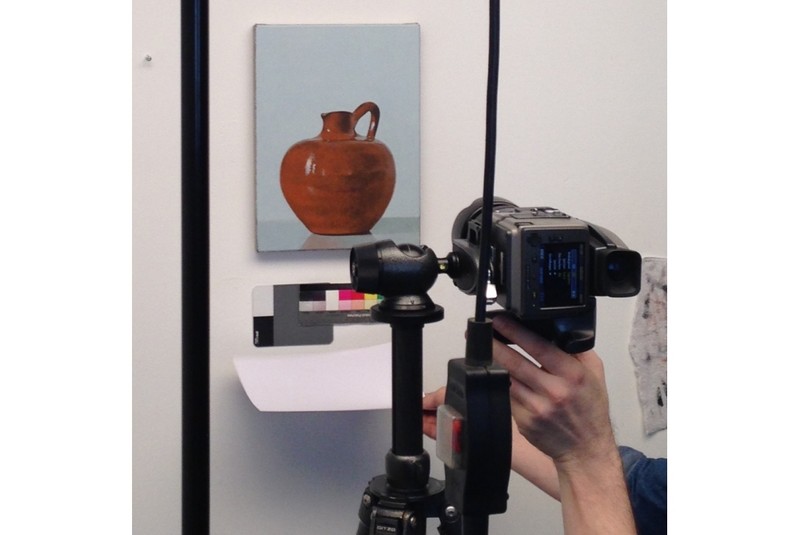Oliver Osborne
23 Apr - 23 May 2015
OLIVER OSBORNE
23 April - 23 May 2015
Catherine Bastide presents the first solo exhibition at the gallery of paintings by Oliver Osborne (born Edinburgh, 1985). These new paintings include found images of cartoons paired with monochrome panels, as well as smaller naturalistic images representing the same orange jar viewed from different angles, in the same lineage as the depictions of rubber plants Osborne has previously painted.
Shown together, these two types of paintings could be interpreted as diverging in manner or technique, yet they both denote an interest in the way images function as a grammar even when they are stripped of language. The cartoons are taken out of their original context –the language textbooks they were appropriated from, their speech bubbles and legends removed, their situational meaning now rendered unintelligible– to meet another “found” tradition in the history of painting, the monochrome. All painting is a found language to some extent, and abstract or figurative distinctions are collapsed; monochrome painting is more “representational” than still life painting.
At first glance, the work looks highly elegant, sophisticated, and polished, in a way that seems almost anachronistic when one considers the high degree of realism and painterly refinement present in the small jar paintings, which contrasts with the apparent simplicity and crudeness of the cartoons and the elegance of the monochrome they’re paired with. Yet all of these pictures function together as a sort of slightly uncomfortable language with its own visual grammar, where the juxtaposition of images creates the same sort of puzzlement we encounter when trying to comprehend and master foreign languages. Oliver Osborne’s visual language is one that understands the historical moment we’re engaged with right now. In a world that comes after appropriation and Photoshop, painting is used as a technology (and not a tool) that appropriates and transforms images.
“I like to think of painting, and oil painting in particular, as a technology that I can use to produce images. It’s a technology that is flexible, crude and technical. The fascinating diversity in its recent history (from Ingres to Krebber perhaps) gives huge scope to painters today [...] I’m often trying to figure out orthodoxy, which in painting is actually very hard to pinpoint”[1]
[1] Oliver Osborne, interview with Guido Santandrea, “Oliver Osborne and the visual communication”, in Arte e Critica, issue 77, Winter 2014, p.57.
23 April - 23 May 2015
Catherine Bastide presents the first solo exhibition at the gallery of paintings by Oliver Osborne (born Edinburgh, 1985). These new paintings include found images of cartoons paired with monochrome panels, as well as smaller naturalistic images representing the same orange jar viewed from different angles, in the same lineage as the depictions of rubber plants Osborne has previously painted.
Shown together, these two types of paintings could be interpreted as diverging in manner or technique, yet they both denote an interest in the way images function as a grammar even when they are stripped of language. The cartoons are taken out of their original context –the language textbooks they were appropriated from, their speech bubbles and legends removed, their situational meaning now rendered unintelligible– to meet another “found” tradition in the history of painting, the monochrome. All painting is a found language to some extent, and abstract or figurative distinctions are collapsed; monochrome painting is more “representational” than still life painting.
At first glance, the work looks highly elegant, sophisticated, and polished, in a way that seems almost anachronistic when one considers the high degree of realism and painterly refinement present in the small jar paintings, which contrasts with the apparent simplicity and crudeness of the cartoons and the elegance of the monochrome they’re paired with. Yet all of these pictures function together as a sort of slightly uncomfortable language with its own visual grammar, where the juxtaposition of images creates the same sort of puzzlement we encounter when trying to comprehend and master foreign languages. Oliver Osborne’s visual language is one that understands the historical moment we’re engaged with right now. In a world that comes after appropriation and Photoshop, painting is used as a technology (and not a tool) that appropriates and transforms images.
“I like to think of painting, and oil painting in particular, as a technology that I can use to produce images. It’s a technology that is flexible, crude and technical. The fascinating diversity in its recent history (from Ingres to Krebber perhaps) gives huge scope to painters today [...] I’m often trying to figure out orthodoxy, which in painting is actually very hard to pinpoint”[1]
[1] Oliver Osborne, interview with Guido Santandrea, “Oliver Osborne and the visual communication”, in Arte e Critica, issue 77, Winter 2014, p.57.

